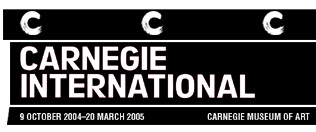Carnegie International 2004
09 Oct 2004 - 20 Mar 2005
Curator:
Laura Hoptman
Artists:
Tomma Abts
Pawel Althamer
Francis Alÿs
Mamma Andersson
Chiho Aoshima
Kaoru Arima
Kutlug Ataman
John Bock
Lee Bontecou
Robert Breer
Fernando Bryce
Kathy Butterly
Maurizio Cattelan
Paul Chan
Anne Chu
Robert Crumb
Jeremy Deller
Philip-Lorca diCorcia
Peter Doig
Trisha Donnelly
Harun Farocki
Saul Fletcher
Isa Genzken
Mark Grotjahn
Rachel Harrison
Carsten Höller
Katarzyna Kozyra
Jim Lambie
Mangelos
Julie Mehretu
Senga Nengudi
Oliver Payne & Nick Relph
Araya Rasdjarmrearnsook
Neo Rauch
Ugo Rondinone
Eva Rothschild
Yang Fudong
Introduction by Laura Hoptman
Immanuel Kant defined the unknowable as "whatever is omnipresent, eternal, or without antecedent cause." Later philosophers used the catchy shorthand of "the Ultimates" to refer to a series of interrelated subjects considered unknowable, including the nature of free will, immortality, the existence of God, and the extent of the universe, to name a few. However constant in human thought, if not in the daily newspapers these questions may be, they have not played a very large role in the cultural discourse of the past thirty years. As Terry Eagleton has recently observed, cultural theory "has been shamefaced about love, biology, religion and revolution, largely silent about evil, reticent about death and suffering, dogmatic about essences, universals and foundations, and superficial about truth, objectivity and disinterestedness." "This," he adds dryly, "on any estimate, is rather a large slice of human existence to fall down on."
In art, grappling with such grand ideas as God, free will, immortality, and ethics was stock in trade throughout history. During the past twenty years, however, an abiding interest in the most prosaic aspects of daily life has served as a strategy for making art relevant to a broader, less elite audience. All this being equal, at this moment in the United States, our undeniable taste for the banal does not quash our need for art that is not merely extracted from aspects of the everyday, but rather wholeheartedly participates in it by wrestling with its fundamental mysteries.
The aim of elucidating some sort of meaning from our world retains the musty odor of the Enlightenment and particularly of a kind of 19th-century essentialism, which in Europe and the United States took forms ranging from a smug Social Darwinism to an idealistic pragmatism. Such anachronistic notions as "universal values" quite rightly cause skepticism today when applied to a cultural topography that now encompasses the entire planet. However, the idea that this understanding precludes the admissibility of more profound investigations is equally of a moment—which has past.
Without succumbing to the local or the anecdotal, the work on display in this Carnegie International broadly investigates the "ultimates" of what it is to be a human being on this earth right now. It does this using a panoply of strategies from empirical observation and scientific deduction to ideological framing to faith and metaphysical speculation, and even mythmaking. And what more appropriate time to do so? As Eagleton has written, "At just the point that we have begun to think small, history has begun to act big."
When Theodor Adorno wrote that "in order for a work of art to be purely and fully a work of art, it must be more than a work of art," he was not implying that art in and of itself wasn't enough; rather, he meant that art was capable of bearing the burden of exploring territories traversed by philosophy, religion, political ideology, and science. More than at any time since immediately after the Second World War, when Adorno published these opinions, it can be argued that the current times call for just this kind of ambition; and the thirty-eight artists in this Carnegie International have risen to this challenge. Without forsaking the sensory excitement, narrative entertainment, and extreme subjectivity that have been the hallmarks of the contemporary art developed over the past ten years, these artists have distinguished themselves in that they have, with some risk, embarked on the more difficult task of choosing art as a meaningful vehicle through which to confront fundamentally human questions: the nature of life and death, the existence of God, the anatomy of belief. This high-stakes view of art-making may not seem extraordinary in light of the entire history of art, but it represents a subtle though important break with the art of our most recent past in that it embodies a search for meaning rather than the construction or illustration of it. The work of these artists proves that the task of investigating the unknowables is one that art can handle. Such an interrogation—sometimes sharp, sometimes gentle—of our own humanity is no less urgent for the uncertainty of its outcome.

